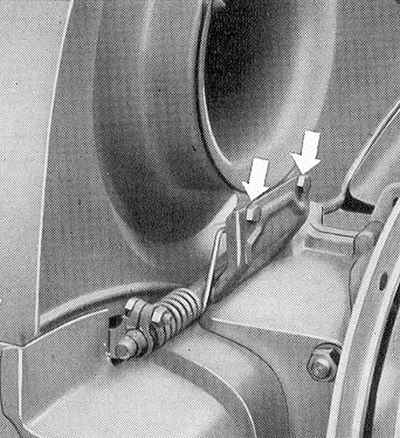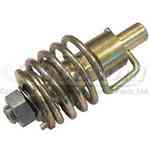The Fresh-Air Heater Thermostat: Going Without
The original VW 36 hp engine and the Porsche 356 engine had a very similar in design and execution terrible heater system. Neither make had thermostatic-controlled air flaps in the fan housing. VW one-upped Porsche in 1962 with the introduction of the heater box "fresh air system" for the heater, a design variant Porsche saved to introduce later in the 911.
To warm up the engine faster (and thus the people), VW added air flaps at the base of the fan housing that were normally closed via a spring load and a thermostat to open them once warm.
The system was designed to fail open if everything else about it was otherwise okay.
But, VW's being cooled by air, most VW mechanics experienced and novice discarded the flap system as soon as possible. It was very nearly SOP.
As the VW evolved from commodity item to restorers prize, the issue of rebuilding with air flap systems is on us. Those who advocate the thermostat system and evangelize for it argue that it was factory designed and the factory knew it's business. That deviation from the system invites wear and doom.
Those who had one foot in the Porsche club and the other in the VW dealership (myself, for one) knew Porsche had never done anything as crazy as design a booby-trap system that could cook an engine like a loose parallelogram of flaps and a little metal bellows thermostat.
Now the truth is, if you have a daily driver in a cold climate and you want quick heat, by all means get yourself a working thermostat system and maintain it.
But if you have a VW hotrod and you want nothing between your fan and cylinders but forced air, just like a 1600 Super, Super 90, SC or 912, go commando.
Your cylinders will not crack. The idea that the flaps might direct air in a better way than random is valid, and there are welded versions of the parallelogram system you can install if you like. But keep in mind no 356 ever cruised down Main St or roared across a finish line with such a contraption. And Porsche used both aluminum and cast iron cylinders.
VW had to modernize its heater to stay competitive and make sales. It's engineering response was reasonable ... but when the 911 debuted with its own heater boxes, the VW-style thermostat was left out.
Make of this what you will.
FJC
The "Fresh-Air" Heater Thermostat: Going Without
- FJCamper
- Moderator
- Posts: 2901
- Joined: Wed Nov 14, 2007 2:19 pm
- Marc
- Moderator
- Posts: 23741
- Joined: Thu May 23, 2002 12:01 am
Re: The "Fresh-Air" Heater Thermostat: Going Without
Yeah, you don't need any of that crap. VW just wanted to spend unnecessary time & money developing it because they were bored. Take it off your engine and send it to me, I'll pay the postage 
- Marc
- Moderator
- Posts: 23741
- Joined: Thu May 23, 2002 12:01 am
Re: The "Fresh-Air" Heater Thermostat: Going Without
Seriously, VWs had thermostats from the beginning. On "non-freshair" engines, cooling air was regulated by a restrictor ring on the inlet of the cooling fan. Also fail-open, one "problem" with it was that it also limited the air supply for cabin heat, since on that design heat & defrost air was merely spent engine-cooling air diverted forward rather than dumped out the back - until the t'stat opened up, there was no flow to defrost the windshield. The other, and arguably more significant shortcoming of that system was that if there were any compression leakage between the heads and cylinders, combustion gasses would enter the cabin and there was a genuine possibility of carbon monoxide poisoning. Even without compression leakage, minor oil leaks (from the pushrod tube seals for example) would cause an oily smell inside.

The new & improved "freshair" system debuted very early in the `63 model year (some early `63s were still non-fresh) to eliminate the "motorized Dachau" effect; they could've retained the same restrictor-ring system for regulating cooling air but chose to incorporate the flap system instead, so that there'd be a good supply of air (albeit not particularly warm air initially) to the defroster vents when the car was first started up.
If the linkage is installed properly it's virtually impossible for anything that might go wrong to cause the engine to overheat - so long as the assembler knows how to check & adjust it, it should NEVER be a problem. The benefit is of course that engine wear is drastically reduced - most wear occurs during warmup, and the last thing you want to do is have a cold blast of air going onto the top of the cylinders, preventing them from expanding, as the pistons inside are heating up and growing.
There is one caveat worth mentioning, however. In Mexico, they went to using a wax-pill thermostat (not unlike the little ones used on some automatic thermostatically-controlled air cleaners) in place of the evacuated bellows with alcohol inside that was used on most VWs.

This design cannot be trusted; by its nature it is NOT fail-safe, if the wax leaks out it will never expand and the flaps will remain closed. If you happen to be unlucky enough to have that type of t'stat on your engine, the lesser evil IMO would be to remove it, or at least adjust it as high up as it will go so the flaps will never be fully-closed....and start looking for the "right" kind. They came in three basic temp ranges, with the `63-`74 being the coolest and most popular...but I'd sooner run a hotter one than none at all.
viewtopic.php?f=18&t=134005&p=1044967
On a related subject, one of the worst insults you can make to your "pre-doghouse" engine (1200, 1300SP, 15/1600SP with the cooler inside the fan shroud) is to remove the cooler and replace it with an external one. Removing the designed-in restriction of the stock cooler results in far more air dumping at the base of the left side cylinders, with the result that there is less cooling available to the right side - in fact, the temperature of the left head may even rise. There are aftermarket shrouds available which have internal vanes patterned after the ones in a stock "doghouse" shroud - these will ameliorate the situation some, but as a rule you're better off sticking with either of the stock arrangements (the doghouse is the superior choice and the ONLY one that should be run on a dualport).
http://www.vw-resource.com/vanes_thermostat.html

The new & improved "freshair" system debuted very early in the `63 model year (some early `63s were still non-fresh) to eliminate the "motorized Dachau" effect; they could've retained the same restrictor-ring system for regulating cooling air but chose to incorporate the flap system instead, so that there'd be a good supply of air (albeit not particularly warm air initially) to the defroster vents when the car was first started up.
If the linkage is installed properly it's virtually impossible for anything that might go wrong to cause the engine to overheat - so long as the assembler knows how to check & adjust it, it should NEVER be a problem. The benefit is of course that engine wear is drastically reduced - most wear occurs during warmup, and the last thing you want to do is have a cold blast of air going onto the top of the cylinders, preventing them from expanding, as the pistons inside are heating up and growing.
There is one caveat worth mentioning, however. In Mexico, they went to using a wax-pill thermostat (not unlike the little ones used on some automatic thermostatically-controlled air cleaners) in place of the evacuated bellows with alcohol inside that was used on most VWs.

This design cannot be trusted; by its nature it is NOT fail-safe, if the wax leaks out it will never expand and the flaps will remain closed. If you happen to be unlucky enough to have that type of t'stat on your engine, the lesser evil IMO would be to remove it, or at least adjust it as high up as it will go so the flaps will never be fully-closed....and start looking for the "right" kind. They came in three basic temp ranges, with the `63-`74 being the coolest and most popular...but I'd sooner run a hotter one than none at all.
viewtopic.php?f=18&t=134005&p=1044967
On a related subject, one of the worst insults you can make to your "pre-doghouse" engine (1200, 1300SP, 15/1600SP with the cooler inside the fan shroud) is to remove the cooler and replace it with an external one. Removing the designed-in restriction of the stock cooler results in far more air dumping at the base of the left side cylinders, with the result that there is less cooling available to the right side - in fact, the temperature of the left head may even rise. There are aftermarket shrouds available which have internal vanes patterned after the ones in a stock "doghouse" shroud - these will ameliorate the situation some, but as a rule you're better off sticking with either of the stock arrangements (the doghouse is the superior choice and the ONLY one that should be run on a dualport).
http://www.vw-resource.com/vanes_thermostat.html